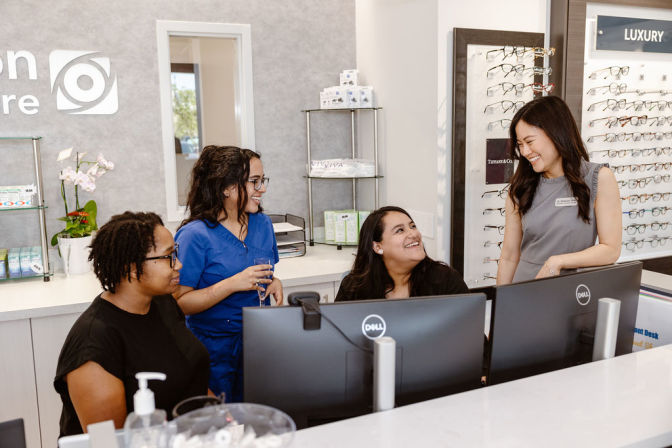How Do Glasses Work?
Chances are that you or someone you know wears eyeglasses each day. A large percentage of the population requires eyeglasses for vision correction, as they make it possible for those with refractive errors to see clearly. But how do glasses work? Continue reading to learn more from your trusted eye doctors at Clarkson Eyecare.

How Do Glasses Work? Understanding Refraction
The science behind glasses comes down to refraction. Refraction is the term for how a wave changes in speed and direction when traveling through different materials.
A light wave moves at its normal speed when traveling through the air. However, the light waves will slow down when they pass through glass. The direction of the light wave can also be adjusted by changing the shape of the glass.
Your anterior eye surface and internal lens work to bend light and focus it on the retina located at the back of the eye. The retina then sends the image to the brain, but this image is not always perfectly focused. If the eye is too long, the image ends up focused in front of the retina instead of directly on it. This refractive error is known as myopia or nearsightedness. This condition can cause objects to appear blurry when seen from far away. Objects up close are seen out of focus when the image is focused behind the retina. This refractive error is commonly referred to as hyperopia or farsightedness.
Another type of refractive error that may need correction is an astigmatism. An astigmatism occurs when the cornea is an uneven shape. This can create more than one focal point, causing images to appear blurry.
The fourth type of refractive error is presbyopia, which occurs when the lens in the eye has difficulties changing shape due to natural aging of the eye. This can make it more difficult to focus light to see up close, making everyday tasks like reading challenging.

How Glasses Have Evolved
Centuries ago, humans discovered we could use glass to refract light and magnify small print. Abbas ibn Firnas is believed to have discovered and created the reading stone in the 9th century.
The Reading Stone
The reading stone was a small piece of glass that could magnify written words. This invention led to the discovery that we can shape glass to modify the light’s refraction, allowing us to correct common refractive errors.
Renaissance Era Eye Wear
The earliest eyeglass lenses were created by glassblowers in the 13th century. These glassblowers found that forming the glass into different shapes would change the amount of refraction the light wave experiences, or how the light changes directions. They then realized that changing the direction of the light could actually help those experiencing vision problems. The first to use these lenses were monks. They were commonly held as a magnifying glass or wore resting on the nose. The form of the eyeglass frames that we know today wouldn’t arrive until the Renaissance era. These frames were fashioned with arms that fit behind the ears and made from wood, bone, and other materials that were readily available.
Benjamin Franklin’s Contributions to Modern Eyeglasses
As the strength of the lenses and focusing power evolved, so did the need for advanced eyeglass options. In 1784, Benjamin Franklin invented the first pair of bifocals. These lenses were designed to help those who experience difficulties with seeing up close and far away, which is commonly referred to as refractive errors. Bifocals are glasses that offer two optical powers in one lens. At first, the two optical powers were just two lens halves glued together. The fused bifocal was then later created in the early 1900s, allowing for a seamless fuse between lenses.
The Advancements of Eyeglass Prescriptions for Presbyopia
An eyeglasses prescription today can provide more than just basic vision correction. They can also treat eye conditions, such as presbyopia. Wearing a pair of reading glasses can provide short-term correction of presbyopia. Those with an existing prescription for distance vision may find it frustrating to switch between your reading glasses and your distance prescription. Thankfully, modern advancements in eye care have allowed us to create bifocal and trifocal lenses.
As previously mentioned, bifocals are eyeglasses that provide two optical powers for up close and distance vision. Trifocals, as denoted by the name, provide three optical powers for up close, mid-distance, and distance vision. These lenses can be created with a clear line or have a smooth transition between each optical power. These lenses are commonly referred to as progressive lenses and are a great option for those that find the line to be distracting.

Schedule an Eye Exam with Clarkson Eyecare
Think you may need glasses? Schedule an eye exam today at your local Clarkson Eyecare. Our team of skilled eye doctors will work with you to determine your eyeglass prescription and treat other eye conditions.